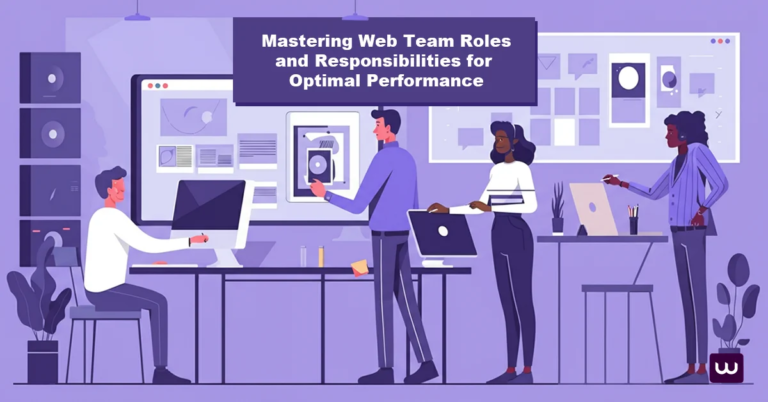
Are you looking for practical ways to improve your website? Integrating social sharing buttons featuring icons of different social media sites can significantly enhance your website’s visibility and increase visitor engagement.
This article offers 15 tips on how to improve your website that can help boost your site’s performance, usability, and search engine ranking. Having a blog on your website is an effective way to encourage user interaction and engage potential customers. From simplifying your homepage to ensuring mobile responsiveness, these strategies will make your website more engaging and successful.
Key Takeaways
Simplifying your homepage with clear messaging and high-quality visuals enhances user engagement and usability.
Mobile responsiveness is crucial for user experience and SEO; ensure your website works well across all device types.
Strong calls to action and effective navigation improve user interactions and guide visitors towards desired actions on your site.
Simplify Your Home Page

The homepage is your business website’s front page and serves as the digital face of your brand. Focusing on essential elements and maintaining a clean design can boost user engagement. Your value proposition should be clear and concise, informing visitors what you do and why it matters. Positioning the key messages at the top of the business website page allows visitors to quickly understand your offering.
Effective use of white space enhances readability and visual appeal, helping users focus on individual content sections, including bullet points, and increasing attention by 20%. Incorporating high-quality visuals into white space that represent your brand can help connect with visitors on a deeper level. Icons as bullet points can further enhance the visual appeal and make information easier to digest.
The ‘less is more’ design principle is essential. Simplify your homepage by eliminating unnecessary content, animations, and low-quality images to enhance performance. A cohesive color scheme with fewer colors can create a harmonious design and make your website more user-friendly.
Lastly, use the 10-Foot Test to make sure your message is clear even from a distance. If visitors can’t grasp it at a glance, refine your messaging and be specific. A well-designed homepage with clear, concise information and high-quality visuals can significantly improve your website’s usability and engagement.
Ensure Mobile Responsiveness

With over half of global web traffic coming from mobile devices, optimizing website design for mobile devices is crucial for any modern website. Google also uses other websites’ mobile-friendliness as a ranking criterion, which directly affects your search engine visibility.
Making a site mobile-friendly is essential to improve user experience and search engine rankings. A non-mobile-friendly website risks losing visitors and suffering lower search engine rankings.Responsive images use attributes like srcset to load appropriately sized images for different devices, enhancing performance.
Employing browser caching allows browsers to store static files, which helps load pages quicker for returning visitors. Continuous testing on actual devices is critical to ensure accurate user experiences that simulators might not replicate.
Mobile responsiveness not only enhances user experience but also plays a vital role in your SEO strategy. A mobile-friendly website can lead to better website performance and higher search rankings, ultimately driving more traffic and engagement.
Enhance Page Speed

Website page speed significantly impacts both user experience and search engine rankings. Prioritizing page speed is crucial as slow loading times, especially on mobile sites, can lead to over 53% of users abandoning the site.
Compressing images before loading them onto your website can significantly boost page speed. Optimizing image loading speed by reducing the image file size without sacrificing quality leads to less load time and better user retention.
Google PageSpeed Insights helps analyze and optimize website performance using various metrics. It offers actionable recommendations like removing render-blocking JavaScript and minimizing redirects to enhance performance.
Limiting the number of HTTP requests made by a webpage can also decrease slow page load times and address slow page speed issues. Minifying CSS and JavaScript files by eliminating unnecessary characters aids in faster load times. Using effective third-party services for hosting, DNS resolution, and caching is key to improving page speed.
A faster website not only provides a positive user experience but also helps to drive traffic and improve search engine rankings.
Craft Engaging Content

Creating relevant content is essential for engaging prospects, building trust, and providing valuable information. Evaluating and enhancing website design and usability are key website improvement ideas. Fresh content is important for both website improvement and SEO since it influences rankings.
Regular updates and website improvement can boost click-through rates and improve rankings. Periodic evaluation of your website content ensures it stays relevant and up-to-date. Including various content types like a blog post, posts, videos, and infographics caters to different audience interests and keeps engagement high.
Visual elements within posts consistently outperform text-only content in engagement metrics. Video content, especially, can draw more visitors and maintain their engagement. Social media promotion can drive traffic, boost visibility, and generate backlinks.
Analyzing audience behavior on specific networks and other sites can help tailor content strategies effectively. Useful, long-form content on business blogs contributes to audience engagement and retention.
Taking a break and seeking feedback is an effective strategy for finalizing website content. Crafting engaging content is an ongoing process that requires regular updates and adaptations to stay relevant and effective.
Implement Strong Calls to Action

Strong calls to action (CTAs) are critical for guiding user interactions and improving conversion rates. CTAs should begin with a verb and include clear action words to encourage user engagement. Using bold and action-oriented language in CTAs can significantly improve user interaction and response.
Testing different colors and visual designs for CTA buttons can lead to higher conversion rates and improve visibility. CTAs should be visually distinct and large enough to read easily, while employing ample white space to draw attention. Creating urgency in CTAs can prompt quick action, and supporting text with visual cues can enhance their impact.
Offering multiple contact methods and clear options can enhance user experience and encourage engagement. Strong CTAs are a vital part of any successful SEO strategy, as they help attract visitors and drive more sales.
Improve Website Navigation

Simplified navigation aids users in finding information quickly and reduces frustration. Effective navigation is key for user experience, helping website visitors find information quickly and shaping their impression of the site. The structure of a website’s navigation should reflect its information architecture, organizing content for user comprehension.
Limiting navigation menu items to no more than seven, enhances clarity and user engagement. Dropdown menus are particularly useful for sites with extensive content, allowing for organized access without overwhelming users. Consistent design and styling across navigation links prevent user confusion.
Internal links play a crucial role in distributing page authority, helping lesser-known pages to gain visibility. Breadcrumbs are a useful navigation tool, allowing users to trace their path back through the site’s structure easily. Better navigation not only helps users find information but also boosts overall engagement and SEO performance.
Focus on Search Engine Optimization

Grasping the intent behind your search engine optimization keywords aligns your content with user needs. Mobile friendliness and responsiveness are crucial elements in any website design tips list. Long-tail keywords are more effective in ranking factor attracting relevant traffic. Title tags should include targeted keywords and the website name to optimize search engine functions.
Using keywords in heading tags engages visitors and boosts SEO performance. Meta descriptions improve SEO by summarizing the page and including relevant keywords, boosting click-through rates. Placing relevant keywords within the first 200 words of content enhances SEO performance.
A structured internal linking strategy helps search engines crawl and index your website efficiently. Utilizing schema tags can enhance visibility in search results by transforming listings into rich snippets. Google Search Console identifies ranking queries, finds new keywords, and shows organic click-through rates.
Optimizing for search engines is essential for achieving online success and using search terms and attracting more site visitors.
Make Contact Information Prominent

Contact information should be easily accessible and typically linked from the homepage. Positioning contact information at the top of the homepage maximizes visibility. Include essential contact information such as address, phone number, and email address. Using contact forms is generally more user-friendly and simplifies the process for users to reach out.
Making contact information prominent not only improves your website’s usability but also helps attract potential customers and increase website users engagement.
Leverage Social Proof

Social proof, like testimonials and quotes from satisfied customers, can significantly enhance a website’s credibility and trustworthiness. Testimonials offer in-depth insights from customers, spotlighting their positive experiences with your service or product. Collect testimonials at times when customers are most satisfied with your service.
Diverse testimonials from various customer segments can enhance appeal to a broader target audience. Adding visual elements like customer photos to testimonials boosts engagement and authenticity. Testimonials should be strategically placed throughout a website to maximize their relevance and impact.
Integrating powerful quotes into headers and marketing materials increases visibility and memorability. Leveraging social proof is a powerful way to create a positive user experience and increase website engagement.
Use High-Quality Visuals

High-quality images are essential as they increase time spent on the site and boost user engagement. Using images strategically can improve search engine ranking opportunities since Google displays more images in results. Incorporating original images can boost user trust and create a meaningful connection with visitors.
Using real images instead of stock photos can significantly raise conversion rates and build user confidence. Design tools like Canva can be leveraged to create high-quality visuals by illustrating concepts or visualizing data effectively.
Using high-quality visuals strategically throughout your website can make it more visually appealing, attract visitors, increase traffic, and help your site rank higher in search results.
Ensure Consistent Design Elements

Maintaining a consistent design helps users feel they are still on the same site, reducing confusion. Drastic design changes between pages can make users feel lost, confused, and distrustful of the site. Visual consistency in design elements, such as color and typography, enhances aesthetic appeal and user engagement.
Functional consistency ensures that interactive elements perform similarly across the site, preventing user confusion. A consistent style throughout elements surrounding the website helps establish brand identity and reinforces user trust.
Use White Space to Your Advantage
White space, also known as negative space, is an essential design element that can greatly improve the user experience of your website. It refers to the empty space between and around elements on a webpage, such as text, images, and buttons. Using white space effectively can make your website feel more modern, clean, and easy to navigate.
Here are some ways to use white space to your advantage:
Reduce Visual Clutter: White space helps to reduce visual clutter, making your website feel more organized and less overwhelming for site visitors.
Draw Attention: It can help to draw attention to specific elements on a page, such as calls-to-action or important information, by creating a focal point.
Improve Readability: Using white space can improve the readability of your website, making it easier for users to scan and understand your content.
Create Hierarchy: White space can help to create a sense of hierarchy on a page, making it clear what information is most important and guiding users through the content.
Increase User Attention: According to Crazy Egg, using white space around text and titles can increase user attention by 20%.
By strategically incorporating white space into your website design, you can enhance the overall user experience and make your site more visually appealing and effective.
Use Color Theory to Enhance User Experience
Color theory is the study of how colors interact with each other and with the human eye. It can be used to create a visually appealing and effective website design. By choosing colors that work well together, you can create a website that is both beautiful and functional.
Here are some tips on using color theory to enhance user experience:
Evoke Emotions: Colors can evoke different emotions and reactions in users, so it’s essential to choose colors that align with your brand and message. For example, blue can evoke trust and calmness, while red can evoke excitement and urgency.
Consistent Color Scheme: Using a consistent color scheme can help to create a sense of brand identity and make your website feel more cohesive.
Create Contrast: Color theory can also be used to create contrast and draw attention to specific elements on a page, such as buttons or important information.
Test Color Variations: According to a study by Maxymiser, testing color variations and action messaging can increase clicks by 11%. Experiment with different color combinations to see what resonates best with your audience.
Accessibility: Using colors that are accessible to users with color blindness can also improve the user experience. Ensure that your color choices provide sufficient contrast and are distinguishable by all users.
By applying color theory principles, you can create a visually appealing website that enhances user experience and encourages user interaction.
Regularly Check and Fix Broken Links

Tools like Ahrefs or SEMrush enable automated scanning of all your images and site for broken links. Google Search Console provides a Crawl Errors report that shows pages returning 404 errors. Screaming Frog is a free desktop application useful for identifying broken links. Online tools like BrokenLinkCheck.com are suitable for smaller websites to check for broken links.
Regularly checking for broken links is essential to maintaining a good user experience and improving search rankings. Repairing broken links enhances the user experience by reducing frustration and helps improve your SEO rankings.
Add Internal Links

Internal linking keeps visitors and search engine robots moving through other pages on the site. Include links to service pages on the homepage, with the name of the service page. Use internal links to connect related content within your site, keeping visitors engaged site longer and improving site SEO.
Strategic internal linking can enhance website navigation, improve user experience, increase traffic, and contribute to better search engine rankings.
Monitor Performance with Google Analytics

Tools like Google Lighthouse and Cloudflare Observatory can effectively evaluate website performance. Regular testing of CTAs helps adapt to changing user behaviors. Set up Google Webmaster Tools and then check for crawl errors to identify any 404 errors on your website. Use tools to identify broken links on your website.
Fixing broken links is essential since they can drive away visitors and lower search rankings. Ensure that your 404 error page provides options to the one page to get users back on track.
Website graders provide easy-to-read reports with actionable guidance to improve performance.
Make Use of Schema Markup

Schema markup makes it easier for search engines to index pages. Schema markup can lead to better rich snippets, improving visibility in search results. JSON-LD is recommended for implementing schema markup because it’s easier to manage and doesn’t interfere with the site’s existing code.
Schema markup enhances your website’s usability, boosts engagement, and strengthens your content marketing strategy.
Continuously Improve and Update Your Website
A website is not a static entity, and it requires continuous improvement and updates to remain effective. By regularly updating your website, you can ensure that it remains relevant, secure, and user-friendly.
Here are some reasons to continuously improve and update your website:
Improve Search Engine Rankings: Regularly updating your website can help to improve search engine rankings and increase visibility. Fresh content and regular updates signal to search engines that your site is active and relevant.
Fix Broken Links: Regular updates allow you to fix broken links, update outdated content, and improve user experience. Tools like Google Analytics can help you identify and address these issues.
Understand User Behavior: Using analytics tools, such as Google Analytics, can help you understand how users are interacting with your website and identify areas for improvement. This data-driven approach allows you to make informed decisions about updates and changes.
Stay Ahead of the Competition: Continuously improving and updating your website can help you stay ahead of the competition and adapt to changing user behaviors and industry trends.
Enhance User Experience: According to Google Webmaster tools, regularly checking and fixing 404 errors can improve user experience and search engine rankings. Ensuring that your website is always up-to-date and functioning smoothly enhances the overall user experience.
By committing to continuous improvement and regular updates, you can ensure that your website remains a powerful tool for your business, driving traffic, engagement, and conversions.
Our Thoughts: Improve Your for Site Visitors
Improving your website involves a multifaceted approach, from simplifying your homepage to leveraging schema markup. By implementing these 15 tips, you’ll enhance user engagement, improve search engine rankings, and create a more positive user experience. Start making these changes today and watch your website transform into a powerful tool for your business.
Frequently Asked Questions
Why is simplifying the homepage so important?
Simplifying the homepage is crucial because it boosts user engagement by making your value proposition clear and navigation intuitive. When visitors can quickly grasp what you offer, they are more likely to explore further.
How does mobile responsiveness impact search engine rankings?
Mobile responsiveness significantly boosts your search engine rankings because Google prioritizes mobile-friendly websites. This means having a mobile responsive site can enhance your visibility and drive more traffic.
What tools can help improve page speed?
Using tools like Google PageSpeed Insights can really help boost your page speed by providing insights on optimizing images, reducing file sizes, and minimizing redirects. Implementing their recommendations can make a noticeable difference in your site’s performance!
How can I create engaging content for my website?
To create engaging content for your website, focus on making it relevant, regularly updated, and diverse by incorporating visuals, videos, and long-form articles when creating content. This variety will attract and keep your visitors coming back for more!
What are the benefits of using schema markup on my website?
Using schema markup can significantly boost your website’s visibility in search results by helping search engines understand your site’s content much better, leading to rich snippets that enhance user engagement. It’s a smart move for improving your overall website performance!




